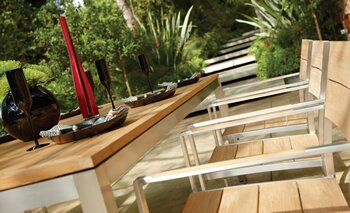 In its rugged, natural state or honed to a stainless shine, stainless steel brings distinctive character to outdoor furniture. Chic and trendy, strong and light, stainless steel can be used in designs where a more stream-lined, slender look is required, which is often desired in contemporary designs but also suits the needs of those furnishing small outdoor spaces.
In its rugged, natural state or honed to a stainless shine, stainless steel brings distinctive character to outdoor furniture. Chic and trendy, strong and light, stainless steel can be used in designs where a more stream-lined, slender look is required, which is often desired in contemporary designs but also suits the needs of those furnishing small outdoor spaces.
The elegance of stainless steel captures the eye when it is combined with other materials such as wood, man-made wicker, or fabric. These combinations offer the perfect balance between style and function. Thus, often the frame will be constructed of aluminium but the seat and back will be another material. This also helps keep costs down, as stainless steel tends to be more expensive than aluminium or wrought iron.
Durability
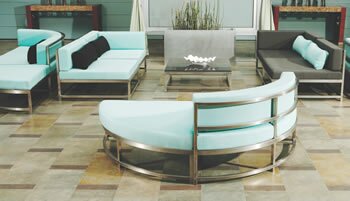 Stainless steel not only looks good, it’s practical and durable. Stainless steel features a specific combination of metals that makes it highly resistant to corrosion. Stainless steel is actually a generic term that describes more than 60 different grades of low carbon steel which contain at least 10% chromium. It is the addition of chromium that gives the stainless steel its corrosion resistance. The chromium combines with oxygen to form an invisible layer of chromium oxide that is self-protective and resists corrosion. If the surface becomes damaged, the chromium-oxide layer reforms within minutes and heals itself.
Stainless steel not only looks good, it’s practical and durable. Stainless steel features a specific combination of metals that makes it highly resistant to corrosion. Stainless steel is actually a generic term that describes more than 60 different grades of low carbon steel which contain at least 10% chromium. It is the addition of chromium that gives the stainless steel its corrosion resistance. The chromium combines with oxygen to form an invisible layer of chromium oxide that is self-protective and resists corrosion. If the surface becomes damaged, the chromium-oxide layer reforms within minutes and heals itself.
Grades and Finishes
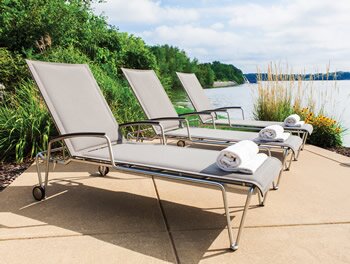 There are different grades of stainless steel and it can be produced in a variety of finishes and textures, including brushed, high-polished, quilted or machine-hammered. The two grades used for outdoor furniture are 316 grade, known as marine grade, and 304 grade, more commonly used for outdoor furniture. Both grades are suitable for use at inland locations whereas 316 grade is recommended for use in coastal, marine or heavily chlorinated environments. The industry standard for outdoor furniture is a 304 grade stainless steel with a fine brushed finish.
There are different grades of stainless steel and it can be produced in a variety of finishes and textures, including brushed, high-polished, quilted or machine-hammered. The two grades used for outdoor furniture are 316 grade, known as marine grade, and 304 grade, more commonly used for outdoor furniture. Both grades are suitable for use at inland locations whereas 316 grade is recommended for use in coastal, marine or heavily chlorinated environments. The industry standard for outdoor furniture is a 304 grade stainless steel with a fine brushed finish.
Stainless steel will not rust; however, it is vulnerable to salt air and chlorine. An electropolished (EP) finish is recommended for furniture used in coastal environments and near a pool. EP is an electrochemical process that removes much of the iron from the surface of the steel, but leaves the chrome intact, resulting in a much improved corrosion resistant surface.
 It’s resistance to corrosion and staining, low maintenance and familiar luster make it an ideal material for outdoor furniture. With proper care, maintenance and placement, stainless steel offers durability and weatherability. Although viewed as having a higher initial cost, the fact is, over the total life of a product, stainless steel is often the best value option.
It’s resistance to corrosion and staining, low maintenance and familiar luster make it an ideal material for outdoor furniture. With proper care, maintenance and placement, stainless steel offers durability and weatherability. Although viewed as having a higher initial cost, the fact is, over the total life of a product, stainless steel is often the best value option.
Stainless steel is also good for the environment because it is 100% recyclable and does not need additional finishing to achieve corrosion resistance nor does it need harsh cleaners to keep it clean. In fact, over 60% of new stainless steel comes from old re-melted scrap.
Care and Maintenance
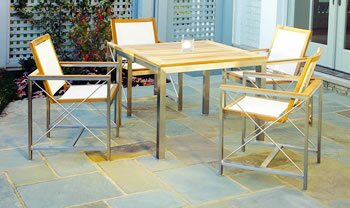 As with any item left permanently outside, stainless steel outdoor furniture requires regular maintenance to keep it looking as new. You should try to clean stainless steel furniture routinely. Cleaning of stainless steel should be done with appropriate non-abrasive cloth and clean, warm water with or without a gentle detergent. Always wipe with the directional grain of the steel, not across it. After washing, rinse with fresh water and dry thoroughly.
As with any item left permanently outside, stainless steel outdoor furniture requires regular maintenance to keep it looking as new. You should try to clean stainless steel furniture routinely. Cleaning of stainless steel should be done with appropriate non-abrasive cloth and clean, warm water with or without a gentle detergent. Always wipe with the directional grain of the steel, not across it. After washing, rinse with fresh water and dry thoroughly.
For finger prints or smudges, you may wish to use a stainless steel cleaner. Always read the manufacturer’s instructions carefully before applying a stainless steel cleaning product. If more aggressive cleaning is required, the type of contaminant needs to be determined and an appropriate cleaner chosen that is safe for stainless steel.
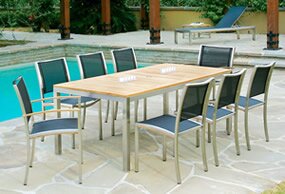 Although stainless steel is generally resistant to corrosion, salt water and air, chlorinated water from a swimming pool and other chemicals may cause discoloration of the surface resulting in small brown spots appearing on its surface (this process is likely to be accelerated in coastal areas). These spots in no way affect the strength, integrity or longevity of the furniture, they are simply superficial discolorations that require cleaning to restore the stainless steel to its original appearance.
Although stainless steel is generally resistant to corrosion, salt water and air, chlorinated water from a swimming pool and other chemicals may cause discoloration of the surface resulting in small brown spots appearing on its surface (this process is likely to be accelerated in coastal areas). These spots in no way affect the strength, integrity or longevity of the furniture, they are simply superficial discolorations that require cleaning to restore the stainless steel to its original appearance.
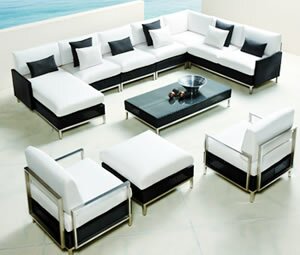 If any brown spots appear on the stainless steel they can be easily cleaned by gently rubbing the surface of the steel, in the direction of the brushed finish, with a Scotch-Brite® pad. If these deposits are allowed to build up, then it may be necessary to clean the product more thoroughly with a stainless steel cleaner polisher, which cleans and restores the new look of stainless steel furniture and makes the surface repellent to both dirt and water.
If any brown spots appear on the stainless steel they can be easily cleaned by gently rubbing the surface of the steel, in the direction of the brushed finish, with a Scotch-Brite® pad. If these deposits are allowed to build up, then it may be necessary to clean the product more thoroughly with a stainless steel cleaner polisher, which cleans and restores the new look of stainless steel furniture and makes the surface repellent to both dirt and water.
Do not use bleach, cleaners containing chlorine, or abrasive cleaners on stainless steel. In addition, steel wool pads or highly abrasive cloths shouldn’t be used. Some of the fine particles can lodge in the surface of the stainless and will eventually rust, giving the appearance that the stainless itself is rusting.
Have questions on the essentials of outdoor furniture and accessories? Just ask we'd be glad to help.





